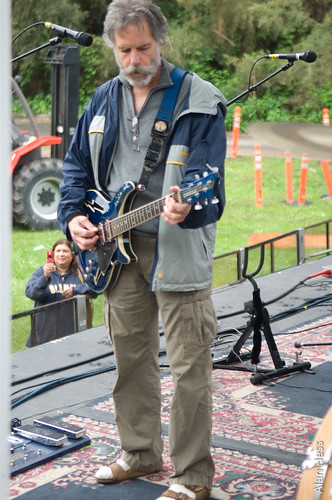
Good Gosh- Another story about Kesey's Tree:
Posted on Sun, Jan. 23, 2005
Oak, witness to '60s counterculture, falls
By S.L. Wykes
KNIGHT RIDDER
The tree they called Ken Kesey's is piled in chunky pieces on Menlo Park's Perry Avenue.
That's the Kesey who wrote "One Flew Over the Cuckoo's Nest" and became an icon of the '60s counterculture revolution.
As a Stanford fellow, he began writing "Cuckoo's Nest" in a minuscule cottage in the shade of that giant oak, a gnarled wonder of nature so daunting the street-pavers split the road around it. Last week, root rot undermined its hold on the ground, and it fell.
Neighbors and old friends of Kesey's came to gather up bits of bark and branch, to have something of a memorable and often-memorialized past. Someone has written a song about the tree, and some others may gather this weekend to say a few words.
It has left a hole in the life of Perry Avenue, more commonly known as a lane. In Kesey's time, four fairytale-scale cottages renting for about $60 a month circled the tree. The neighborhood, its streets without gutters or curbs, was slammed by some as a rural slum but was popular with Stanford University graduate students and young professors.
When Kesey brought his lightning rod energy to the neighborhood in 1958, he drew a who's who of artists, musicians and writers to parties punctuated with jazz and rock and poetry.
A Beat generation hero, Neal Cassady, showed up one day on Perry, "talking a mile a minute and trying to fix a blown transmission," said Robert Faggen, the Claremont McKenna College professor who is writing a biography of Kesey.
Cassady and Kesey clicked, and, when Kesey took off on a cross-country trip, Cassady drove the psychedelically painted bus carrying Kesey's Merry Pranksters.
The Grateful Dead's Jerry Garcia and Phil Lesh made music under the tree, too, when it became a natural centerpiece for infamous parties. The gatherings eventually drew hundreds who came to share the sense of freedom to be found in the early '60s on Perry.
"It was a hopeful time," said Chloe Scott, a Menlo Park dancer who joined many revelries. "There was a feeling we were on the verge of some wonderful discovery of how to live."
Like many symbols, the tree accumulated its own mythology. There was a basketball hoop on the tree, but never were its branches the site of LSD-fueled stargazing, Scott said, frustrated at having to quash an oft-repeated inaccuracy.
"Knowing the Perry lane world, I would think that someone must have tried it once, but it wasn't a very climbable tree," said Vic Lovell, who lived on the lane for many years. He's the same Vic Lovell to be found on the dedication page of "Cuckoo's Nest."
The tree did stand as a game post for the Perry Lane Olympics, which pitted some former Stanford athletes and former wrestler Kesey in three-legged races. The games always kicked off with the march of a topless torch-carrier. "Ken was always able to persuade some particularly gorgeous young woman to carry the torch," Lovell said. The torch was a toilet plunger.
After almost five years, rich with new friends and ideas, the Keseys moved to La Honda in 1963, when Stanford sold the land to a developer. The night before they left, there was a cottage demolition wake warmed by a big bonfire. A piano the Keseys couldn't take to their new home ended up as a fiery sacrifice.
The further adventures of Kesey and his cohorts became a part of Tom Wolfe's "Electric Kool-Aid Acid Test," a classic piece of cultural journalism. "Cuckoo's Nest" was an instant bestseller and has never been out of print.
The tree became a shrine of sorts. Visitors, some from overseas, came to touch its weathered trunk. Just this summer, Perry Avenue homeowner Maria Stiles saw a group of German students encircling its trunk on a pilgrimage.
The oak remained a beloved part of the street, even as the tiny cottages disappeared to be replaced by homes priced at $1 million-plus. When someone moves in, it's likely they already know the tree's story. Every July 4, longtime Perryites Anne and Paul De Carli host a party, which inevitably encompasses the tree.
Make that encompassed. San Mateo County, which has jurisdiction on the street, hasn't told anyone yet how the hole in the middle of the street will be filled. Everyone wants a new tree.
The oak, Kesey's widow, Faye, said during a phone interview from her home in Oregon, "tied everybody together in some way. All of us could look out our windows and see it."
She's not sure how sentimental her husband might have been about the tree's death, three years after his own. "But he would like to have seen it used for something," she said. Maybe a sculpture, "or a nice bench, something to have as a reminder."






